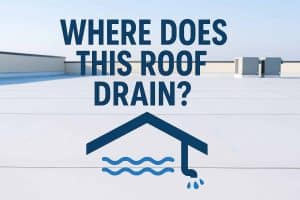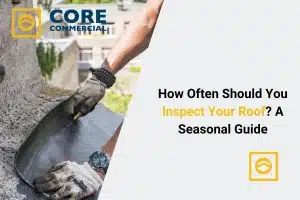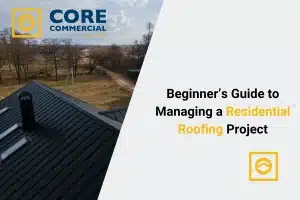Re-roofing a commercial building in Texas isn’t cheap. Whether you own a shopping center, warehouse, school, or office building, re-roofing can easily cost thousands—or even hundreds of thousands—of dollars. But that doesn’t mean you’re stuck with sky-high costs. With the right knowledge and decisions, you can save a significant amount of money without cutting corners on quality or performance.
This guide breaks down eight practical, proven Tips for Commercial Re‑Roofing that help Texas business owners, facility managers, and property investors save money on commercial re-roofing projects. These aren’t just generic ideas—they’re specifically geared toward Texas properties, climate conditions, and roofing regulations. If you’re planning a roof replacement or just considering it, this guide will give you the clarity and control you need to make smart, cost-effective decisions.

Table of Contents
1. Choose the Right Time of Year for Your Re-Roof
When you schedule your re-roofing project can significantly impact your final cost. In Texas, roofing contractors are busiest in late spring and summer—right before hurricane season or right after severe hailstorms. This high demand often means higher labor rates, longer wait times, and less flexibility.
Best seasons for savings:
- Late fall (October–November): Cooler temperatures, fewer storms, and off-peak rates.
- Early winter (December–February): Contractors are less booked, and material prices may drop.
Scheduling your re-roof during these lower-demand months can help you negotiate better rates and ensure your project is completed faster, with less competition for materials and labor.
2. Know Which Materials Perform Best in Texas
Texas isn’t gentle on roofs. Between intense sun, high humidity, hailstorms, and even hurricanes in some regions, your roofing material needs to handle a lot. Choosing the wrong type of material could lead to higher repair and energy costs later.
Most cost-effective roofing materials for Texas commercial buildings:
- TPO (Thermoplastic Polyolefin): Affordable, reflective, and energy-efficient. Great for flat roofs in hot areas like Dallas, Austin, and Houston.
- Metal Roofing: Higher upfront cost, but excellent durability against hail, wind, and heat. Often lasts 40+ years.
- Modified Bitumen: Popular for low-slope roofs; budget-friendly and durable in variable weather.
- Spray Foam Roofing: Creates a seamless layer with high insulation value—great for reducing cooling costs.
Ask for an energy-efficient roof that meets Texas building codes and reflects heat away from your building. This small step can lower indoor cooling costs and qualify you for energy rebates in certain cities.
3. Don’t Ignore Preventative Maintenance
One of the biggest mistakes Texas building owners make is waiting too long to deal with roof issues. By the time you see interior leaks or major damage, it’s usually too late for minor repairs—now you’re looking at a full replacement.
Save money by getting ahead:
- Schedule annual roof inspections (especially after hailstorms or hurricanes).
- Clean gutters and drains regularly to prevent water pooling.
- Seal cracks and replace flashing early to stop leaks before they grow.
Preventive maintenance extends your roof’s life and helps you avoid emergency replacements that are often rushed and overpriced.
4. Get a Detailed Roof Inspection First
Before you commit to a re-roofing project, invest in a professional roof inspection. A thorough inspection helps you understand what you need—whether it’s a full replacement, partial overlay, or just strategic repairs.
What a proper inspection should include:
- Infrared moisture scanning to detect hidden water damage.
- Evaluation of insulation, deck condition, and ventilation systems.
- Drainage system check to prevent future ponding issues.
Knowing exactly what’s wrong can help you avoid unnecessary costs and ensure you’re not replacing more than you have to. In many Texas cities, roofing permits also require a formal inspection, so doing it early saves time later.
5. Avoid Full Tear-Offs if You Can
Tearing off the old roof and starting from scratch is expensive and messy. In many cases, you may be able to install a new roofing system over your existing one, saving thousands in labor and debris removal.
Texas building code generally allows up to two layers of roofing on commercial buildings, provided the deck is structurally sound and there’s no major moisture damage.
Benefits of an overlay instead of full tear-off:
- Cuts project time in half.
- Saves on labor and disposal costs.
- Reduces disruption to your business operations.
Just make sure you’re not layering over a damaged roof. That’s why a detailed inspection (Tip #4) is so important.
6. Hire a Local Roofing Contractor with Texas Expertise
Out-of-state roofing companies often show up after major storms in Texas. While some are legitimate, many are “storm chasers” who cut corners, overcharge, and disappear after the job is done.
Why local contractors save you more in the long run:
- They understand Texas weather, codes, and materials.
- They’re more accountable for long-term warranties and service.
- Local teams are easier to reach for follow-ups or maintenance.
Check their credentials:
- Are they licensed and insured in Texas?
- Do they have commercial roofing experience in your city?
- Can they provide local references or portfolio examples?
You’re not just hiring someone to install a roof—you’re building a relationship that can affect your building’s performance for decades.
7. Understand Warranty Options That Save Money Long-Term
Many commercial re-roofing jobs include warranties, but not all warranties are created equal. A good warranty can protect you from unexpected costs for 10, 20, or even 30 years.
Key types of warranties:
- Manufacturer Warranty: Covers defects in roofing materials.
- Workmanship Warranty: Covers installation errors by the contractor.
- Extended or NDL (No Dollar Limit) Warranty: Offers the most comprehensive coverage, often required for larger facilities.
Ask detailed questions about what’s covered, who’s responsible for inspections, and whether you can transfer the warranty if you sell the building. A strong warranty might cost more upfront, but could save tens of thousands over time.
8. Explore Financing and Incentives Available in Texas
If you’re managing a tight budget, you don’t have to pay for everything out of pocket. Many Texas cities and utilities offer financial incentives, tax breaks, and low-interest financing for energy-efficient roofing systems.
Options to explore:
- PACE (Property Assessed Clean Energy) financing: Available in several Texas counties; lets you finance roofing upgrades through your property taxes.
- Utility Rebates: Companies like Oncor and CenterPoint offer rebates for cool roofs and insulation upgrades.
- Federal Energy Tax Credits: Depending on your roofing material and installation, you may qualify for up to 10% in federal energy credits.
Talk to your roofing contractor about these programs—they can often help you apply and calculate the long-term savings.
Tips for Commercial Re‑Roofing: Spend Smarter, Not More
Re-roofing your commercial building in Texas doesn’t have to drain your budget. With the right planning, smart material choices, reliable contractors, and local rebates, you can cut costs without sacrificing quality. Each of these eight tips is designed to help you make educated, cost-effective decisions from start to finish.
What’s next?
Before you start calling contractors or buying materials, take a step back. Use this guide to create a re-roofing strategy. Focus on your building’s long-term performance, not just the lowest bid. When done right, your new roof won’t just protect your property—it’ll save you money for decades to come.
FAQs
What is the best time to replace a commercial roof in Texas?
The ideal time to replace a commercial roof in Texas is during the fall or early winter. These seasons offer moderate temperatures and less rainfall, providing optimal conditions for roofing projects and potentially lower costs due to off-peak demand.
Which roofing material is most cost-effective in Texas?
TPO (Thermoplastic Olefin) roofing is among the most cost-effective options in Texas. It’s durable, energy-efficient, and performs well in the state’s varied climate, making it a popular choice for commercial buildings.
How can I save money on commercial roof replacement?
To save money on commercial roof replacement, schedule the project during off-peak seasons, choose cost-effective materials like TPO, and consider overlaying new roofing over existing layers if building codes permit. Regular maintenance can also extend roof life, delaying the need for replacement.
Are there any Texas incentives for energy-efficient roofing?
Yes, Texas offers incentives like the Property Assessed Clean Energy (PACE) program, which provides financing for energy-efficient roofing upgrades. Additionally, some utility companies offer rebates for installing reflective roofing materials that reduce energy consumption.
Is it better to repair or replace a commercial roof in Texas?
If your commercial roof has minor issues, repairs may suffice. However, if it’s over 20 years old or has significant damage, replacement is often more cost-effective in the long run, especially when considering energy efficiency and maintenance costs.
How often should a commercial roof be inspected in Texas?
It’s recommended to inspect your commercial roof at least twice a year, preferably in the spring and fall. Regular inspections help identify and address issues early, preventing costly repairs and extending the roof’s lifespan.
Can I install a new roof over an existing one in Texas?
In many cases, Texas building codes allow for a new roof to be installed over an existing one, provided the structure can support the additional weight and the existing roof is in suitable condition. This approach can save on labor and disposal costs.
What maintenance tips help extend a commercial roof’s life?
Regular maintenance, including cleaning gutters, removing debris, inspecting for damage, and addressing issues promptly, can significantly extend the life of a commercial roof. Applying reflective coatings can also protect against UV damage.
How can I find a good commercial roofing contractor in Texas?
Look for contractors with proper licensing and insurance, positive local references, and experience with commercial roofing projects. Verify their credentials and ensure they offer warranties on both materials and workmanship.
What are the signs that my commercial roof needs replacement?
Signs include persistent leaks, visible damage, sagging areas, and increased energy bills. If your roof is nearing or has exceeded its expected lifespan, it’s wise to consult a professional for an assessment.





